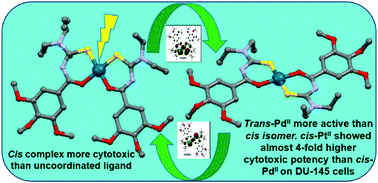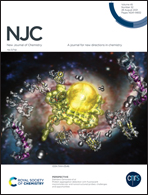Photoactive PtII and PdII complexes of N,N-diethyl-N′-3,4,5-trimethoxybenzoylthiourea: synthesis, crystal structures, DFT and cytotoxicity studies†
Abstract
Photo-chemical isomerism of the cis-[PdII/PtII(L-κS,O)2] complexes of N,N-di-ethyl-N′-3,4,5-trimethoxy-benzoylthiourea (HL) in acetonitrile reversibly produces geometric trans-[PdII/PtII(L-κS,O)2] isomers in solution after irradiation with visible light, as determined by 1H NMR, UV-vis and reverse phase chromatography (RP-HPLC). Single-crystal X-ray diffraction studies reveal that the new trans-[PdII/PtII(L-κS,OκS,O)2] complexes crystallize in a triclinic P![[1 with combining macron]](https://www.rsc.org/images/entities/char_0031_0304.gif) space group, with the sulfur and oxygen donor atoms arranged trans to each other in the six-membered chelate. Structural analysis of the cis- and trans-[PdII/PtII(L-κS,O)2] complexes performed using time-dependent DFT at the B3LYP/CEP31-G level of theory reveals that the cis-[PdII/PtII(L-κS,O)2] complexes are more stable than their trans-[PdII/PtII(L-κS,O)2] counterparts. The cytotoxicity of the HL ligand and its corresponding cis-[PdII/PtII(L-κS,O)2] and trans-[PdII(L-κS,O)2] complexes was investigated against the human prostate cancer cell line (DUI45) and the normal embryonic kidney cell line (HEK-293). Cytotoxicity was evident after complexation with the HL ligand. In particular trans-[PdII(L-κS,O)2] and cis-[PtII(L-κS,O)2] complexes produced a significant dose-dependent decrease in cell viability of both cell lines. cis-[PtII(L-κS,O)2] presented the most cytotoxic activity against DUI45 and comparable selectivity to doxorubicin, a commonly used anticancer drug, indicating its potential as a Pt-based anticancer compound.
space group, with the sulfur and oxygen donor atoms arranged trans to each other in the six-membered chelate. Structural analysis of the cis- and trans-[PdII/PtII(L-κS,O)2] complexes performed using time-dependent DFT at the B3LYP/CEP31-G level of theory reveals that the cis-[PdII/PtII(L-κS,O)2] complexes are more stable than their trans-[PdII/PtII(L-κS,O)2] counterparts. The cytotoxicity of the HL ligand and its corresponding cis-[PdII/PtII(L-κS,O)2] and trans-[PdII(L-κS,O)2] complexes was investigated against the human prostate cancer cell line (DUI45) and the normal embryonic kidney cell line (HEK-293). Cytotoxicity was evident after complexation with the HL ligand. In particular trans-[PdII(L-κS,O)2] and cis-[PtII(L-κS,O)2] complexes produced a significant dose-dependent decrease in cell viability of both cell lines. cis-[PtII(L-κS,O)2] presented the most cytotoxic activity against DUI45 and comparable selectivity to doxorubicin, a commonly used anticancer drug, indicating its potential as a Pt-based anticancer compound.



 Please wait while we load your content...
Please wait while we load your content...